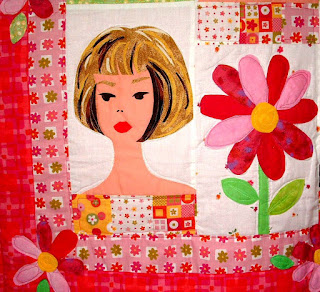I wanted to try a modern color scheme, and so chose green fabric and black embroidery thread.
I found a leaf print that added colors, including red, and set in a small border of red and green woven plaid. The blocks sat and languished for a year. I hope I get it quilted before another year goes by!
One of my favorite people on this quilt is Lois Gibbs, the Love Canal mom and activist.
Love Canal is not far from where I grew up in Tonawanda, NY. On Sunday afternoons we would drive to Niagara Falls and be back in time for dinner.
This part of New York is an industrial center. When we went to visit my cousins on Grand Island in the Niagara River, we passed the Ashland Oil refinery which lined the road near the Grand Island Bridges. It smelled! In front of our house was an Ashland gas station which my grandfather had built in the late 1940s. My family sold the house and station in 1963, and several years later they were torn down and an apartment building was built on the site..
We'd go boating on the Niagara River and pass industrial sites of all kinds. The Tonawanda dumps, where my dad used to go as a kid, was full of hazardous waste. Uranium from the Manhattan Project, the development of the atomic bomb, was dumped there! (We actually own a painting found in the Tonawanda Dump in the early 1970s. I wonder if we should get it tested for radioactivity!)
The Linde Air Products plant was near the housing project in Sheridan Park where my mom grew up. Known as 'the Projects,' the duplexes housed the influx of workers for the war plants. My grandfather was an engineer at a Chevy plant. A 2001 report by Don Finch of F.A.C.T.S. states that the Tonawanda problems is not "as bad as the Love Canal findings of the 1970s" but he sees the entire Western New York area as a chemical wasteland. "If you move here you have a choice. Do you want to live on top of radioactive, toxic, or heavy metal materials?" The area's cancer cases were 10% higher than expected.
http://factsofwny.org/fundmtls.htm; http://westvalleyfactsofwny.org/chrono.htm
Love Canal began as a scheme to connect the Niagara River with Lake Ontario. Money ran out and water filled the site. In the 1920s, the canal became a City of Niagara dump. In the 1940s, the U.S. Army used the dump, including for waste from the Manhattan Project. Hooker Electrochemical Company also used this site as a dump until 1953. Hooker sold the property to the City of Niagara for $1. In 1955 the City of Niagara built a school on the property, and a second on was built a year later.And in 1957 the Love Canal housing project was built.
In 1976 reporters found toxic chemicals in sump pumps in the area. Birth defects and health problems were reported at higher than normal levels. On August 2, 1978, Lois Gibbs founded the Love Canal Homeowners Associations. The activists fought for four years until President Carter allocated government funds to Love Canal clean up. Nearly 900 families were relocated, and reimbursed for their lost homes. Congress passed the Superfund Act because of Love Canal.
In 1981 Lois created the Center for Health, Environment, and Justice.She proved that through activism, people can change the world.
Hooker Chemical also left behind a polluted area in Montague, MI, where we lived for four years. The site was fenced off, but it had not been cleaned up Residents there were concerned that in the future people would forget its history, and build there.
My parents both died of cancer. When mom was diagnosed in 1990, at age 57, she was asked if she had been exposed to toxins, and she thought of Love Canal and the polluted corridor of Western New York.
For more information on Lois Gibbs:
http://chej.org/about/our-story/about-lois/
http://www.fredonia.edu/convocation/gibbsbio.asp





























